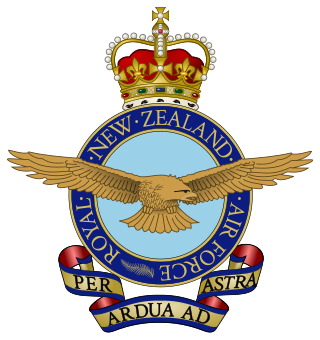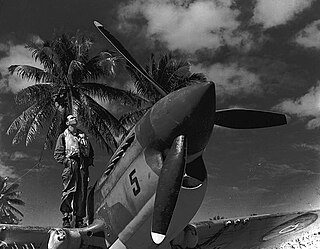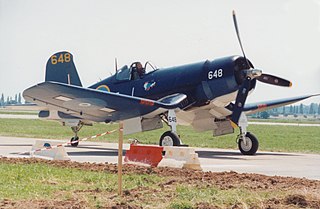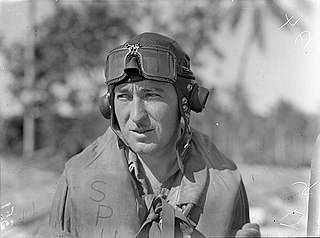
The Royal New Zealand Air Force is the aerial service branch of the New Zealand Defence Force. It was formed initially in 1923 as a branch of the New Zealand Army, being known as the New Zealand Permanent Air Force, becoming an independent air force on 1 April 1937.

The Lockheed Hudson is a light bomber and coastal reconnaissance aircraft built by the American Lockheed Aircraft Corporation. It was initially put into service by the Royal Air Force shortly before the outbreak of the Second World War and primarily operated by it thereafter. The Hudson was a military conversion of the Model 14 Super Electra airliner, and was the first significant aircraft construction contract for Lockheed — the initial RAF order for 200 Hudsons far surpassed any previous order the company had received.

14 Squadron RNZAF is a squadron of the Royal New Zealand Air Force. In 2015 the squadron was re-raised and equipped with 11 Beechcraft T-6 Texan II. A new aerobatic display team called the Black Falcons was also formed using the new aircraft. They replaced the RNZAF display team known as the Red Checkers.
No. 75 Squadron was a unit of the Royal Flying Corps and Royal Air Force in World War I and the RAF in World War II. In 1940–1945, it was a bomber unit comprised mainly of New Zealand-born personnel. In October 1945, the squadron number – along with its heraldry and honours – was relinquished by the RAF and transferred to the Royal New Zealand Air Force, officially becoming No. 75 Squadron RNZAF. No other RAF squadron has been gifted in this way, to another Commonwealth air force.

No. 15 Squadron was a fighter squadron of the Royal New Zealand Air Force that was formed in June 1942. It served in Tonga, Guadalcanal, New Georgia, Espiritu Santo, Bougainville and Green Island. The squadron was equipped with Kittyhawk and, later, F4U Corsair fighters. The squadron was disbanded in October 1945.

No. 16 Squadron was a fighter squadron of the Royal New Zealand Air Force. Formed in July 1942 at RNZAF Base Woodbourne, the squadron was equipped with Curtiss P-40 Kittyhawks and later F4U Corsairs. The squadron fought in the Southwest Pacific theatre during the Second World War, flying combat operations against Japanese forces. Proposed re-equipment with the P-51 Mustang was abandoned at the cessation of hostilities, and the squadron returned to New Zealand where it was disbanded in October 1945.

No. 488 Squadron was the name given to two distinct Royal New Zealand Air Force squadrons during the Second World War. Both were formed under Article XV of the Empire Air Training Scheme and served under the operational command of the Royal Air Force.

The Vickers Vildebeest and the similar Vickers Vincent were two very large two- to three-seat single-engined British biplanes designed and built by Vickers and used as light bombers, torpedo bombers and in army cooperation roles. First flown in 1928, it remained in service at the start of the Second World War, with the last Vildebeests flying against Japanese forces over Singapore and Java in 1942.

No. 487 (NZ) Squadron was a light bomber squadron established for service during the Second World War. It was a New Zealand squadron formed under Article XV of the Empire Air Training Plan. Although many of its flying personnel were largely drawn from the Royal New Zealand Air Force, the squadron served in Europe under the operational and administrative command of the Royal Air Force as part of Bomber Command. Formed in mid-1942, it operated the Lockheed Ventura and then the de Havilland Mosquito and took part in over 3,000 operational sorties before being disbanded at the end of the war in late 1945.

No. 1 Squadron RNZAF was a New Zealand reconnaissance and patrol bomber squadron operating in the Pacific Theatre during World War II. After the war the squadron served in the transport and VIP role.
No. 4 Squadron RNZAF was a Royal New Zealand Air Force (RNZAF) patrol bomber unit that served in the South Pacific during World War II.
No. 8 Squadron RNZAF was a New Zealand Bomber Reconnaissance squadron in the South Pacific during World War II.
No. 9 Squadron RNZAF was a New Zealand bomber reconnaissance squadron in the Pacific Theatre of World War II.

Group Captain Desmond James Scott, was a New Zealand fighter pilot and flying ace of the Second World War. He was credited with the destruction of at least five enemy aircraft.

No. 22 Squadron RNZAF was a squadron of the Royal New Zealand Air Force. Formed in August 1942, during World War II, at RNZAF Station Onerahi equipped with the Hawker Hind, co-ordinating with New Zealand Army units providing training for air liaison officers. Reformed on 19 June 1944 at RNZAF Station Ardmore, equipped with Chance-Vought F4U-1 Corsair fighter bombers. The squadron served at airfields in Espiritu Santo, Guadalcanal, Bougainville and Emirau before being disbanded in September 1945.

Reginald Joseph Cowan Grant, was a New Zealand flying ace of the Royal New Zealand Air Force (RNZAF) in the Second World War.

No. 485 (NZ) Squadron was a fighter squadron established for service during the Second World War. It was the first New Zealand squadron formed under Article XV of the Empire Air Training Plan. Although many of its flying personnel were largely drawn from the Royal New Zealand Air Force, the squadron served in Europe under the operational and administrative command of the Royal Air Force.

Air Vice-Marshal Ian Gordon Morrison, was a New Zealand aviator and military leader. Born in Hanmer Springs, he briefly served in the Royal Air Force before transferring to the Royal New Zealand Air Force in 1939. During the early stages of the Second World War, he was a bomber pilot with No. 75 Squadron, which was formed mostly with New Zealand personnel and operated Vickers Wellingtons. He returned to New Zealand in 1940 for instructing duties and then was a staff officer with the RNZAF's No. 1 Islands Group, based in Vanuatu. He later commanded No. 3 Squadron during the Solomons campaign. After the war, he held a series of staff posts before becoming Chief of Air Staff of the RNZAF in 1962. In this capacity he replaced much of the air force's dated equipment and sought to improve its strike capacity. Appointed a Companion of the Order of the Bath in 1965, he retired the following year. He died in 1997, aged 83.

Robert Lawrence "Peter" Spurdle was a New Zealand flying ace of the Royal Air Force (RAF) during the Second World War. He was credited with the destruction of ten enemy aircraft.

Mervyn Robert Bruce Ingram, was a New Zealand flying ace of the Royal New Zealand Air Force (RNZAF) during the Second World War. He is credited with at least eight aerial victories.















